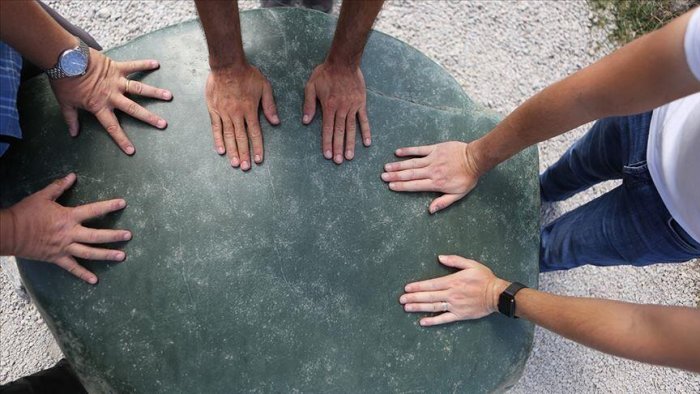Mystery Of The Ancient Giant Wish Stone At Hattusa
Conny Waters - AncientPages.com - There is a mysterious giant ancient green rock in the capital of the Hittite Empire in central Turkey. Anyone who visits Hattusa, the capital of the empire can admire this beautiful and rare stone, but its history is shrouded in secrets.
The holy green stone at Huttusa. Credit: Carole Raddato, Public Domain
Locals refer to it as the wish stone, but it’s unclear what the stone was used for. The green rock doesn’t appear to have any valuable properties, but it was nevertheless important to many ancient civilizations who once inhabited the region.
The Hittites were once one of the most powerful ancient civilizations that occupied the ancient region of Anatolia.
This long-gone culture has been of great interest to archaeologists and historians but unraveling the truth about the Hittites has been a difficult task. A majority of the Hittites were illiterate and could not describe their daily life. The information we possess about the Hittites come from ancient clay tablets.
However, the green rock remains a centuries-old mystery and there is no mention of the stone on the stone tablets.
Scientists have long tried to figure out why the rock was carried to the ancient site and what it was used for. According to researchers the green rock is different from all others found at the site but does not have valuable properties.
See also:
Ancient Dragon Stone That Inspired Legends Discovered In Turkey
Stone Of Scone: Mysterious Stone Of Destiny Has Turbulent Ancient History
Tracing Footsteps Of Giants In Africa – Obscure Past Of Mzoura Stones
Associate Professor Andreas Schachner who examined the stone said it could be a serpentine or a nephrite, but it’s still a mystery why it has attracted the attention of our ancestors.
It’s not a special stone but special stone, but it is remarkable that it is preserved monolithically. Perhaps ancient people valued it because of its wonderful green color.
Image credit: Hurriet Daily News
Stone worship was widespread in ancient times, and it “is one of the oldest forms of religion of which we have evidence. It has frequently persisted in venerable cults in the midst of high stages of civilization and in the presence of elevated religious conceptions, while its survivals in popular superstitions have proved nearly ineradicable.” 1
Stones of worship could be of different size and shape. “The holy stone was sometimes a natural rock, of striking form or position, in situ; sometimes a prehistoric megalith; more frequently a rude block set up for a purpose. “2
Hole stones were often used as altars, or as we suspect in the case of the green Hattusastone they made have been a place where people gathered to make special wishes.
Written by Conny Waters – AncientPages.com Staff Writer
Copyright © AncientPages.com All rights reserved. This material may not be published, broadcast, rewritten or redistributed in whole or part without the express written permission of AncientPages.com
Expand for references- Encyclopedia Biblica, III, 2279; cf.3352
- Moore, George F. "Baetylia." American Journal of Archaeology7, no. 2 (1903): 198-208. doi:10.2307/496676.
More From Ancient Pages
-
 Movie Stars’ Creepy Encounters With The Unexplained
Featured Stories | Oct 28, 2019
Movie Stars’ Creepy Encounters With The Unexplained
Featured Stories | Oct 28, 2019 -
 On This Day In History: Explorer Of The New World Amerigo Vespucci Born – On Mar 9, 1451
News | Mar 9, 2017
On This Day In History: Explorer Of The New World Amerigo Vespucci Born – On Mar 9, 1451
News | Mar 9, 2017 -
 Reconstructed Roman Gateway Tells The Story Of Britain’s Invasion
Featured Stories | Aug 26, 2023
Reconstructed Roman Gateway Tells The Story Of Britain’s Invasion
Featured Stories | Aug 26, 2023 -
 Ancient Maya Used An Unknown And Ingenious Method To Prevent Tooth Decay And Infections – Scientists Say
Archaeology | May 24, 2022
Ancient Maya Used An Unknown And Ingenious Method To Prevent Tooth Decay And Infections – Scientists Say
Archaeology | May 24, 2022 -
 First Bronze Age Settlement Predating The Phoenicians Discovered In Maghreb
Archaeology | Mar 5, 2025
First Bronze Age Settlement Predating The Phoenicians Discovered In Maghreb
Archaeology | Mar 5, 2025 -
 Pooka: Solitary Spirit And Not Entirely Benevolent Prankster In Irish Folklore
Celtic Mythology | Jun 4, 2016
Pooka: Solitary Spirit And Not Entirely Benevolent Prankster In Irish Folklore
Celtic Mythology | Jun 4, 2016 -
 DNA Evidence Ice Age Humans Migrated From China To The Americas And Japan
DNA | May 9, 2023
DNA Evidence Ice Age Humans Migrated From China To The Americas And Japan
DNA | May 9, 2023 -
 Ancient City Of Gordium, Gordian Knot And Skeleton In Tumulus Of King Midas
Civilizations | Sep 20, 2018
Ancient City Of Gordium, Gordian Knot And Skeleton In Tumulus Of King Midas
Civilizations | Sep 20, 2018 -
 King Sanakht: Mysterious Ancient Egyptian Pharaoh Was A ‘Giant’ – Scientists Say
Archaeology | Aug 9, 2017
King Sanakht: Mysterious Ancient Egyptian Pharaoh Was A ‘Giant’ – Scientists Say
Archaeology | Aug 9, 2017 -
 Chain Mail Reveals Roman Soldiers Recycled And Repaired Their Own Armor
Archaeology | Dec 12, 2024
Chain Mail Reveals Roman Soldiers Recycled And Repaired Their Own Armor
Archaeology | Dec 12, 2024 -
 Mysterious Lost City Of The Tairona Hidden In The Jungles Of Colombia
Civilizations | Nov 9, 2018
Mysterious Lost City Of The Tairona Hidden In The Jungles Of Colombia
Civilizations | Nov 9, 2018 -
 What Is The Codex Sinaiticus And What Does It Mean?
Ancient History Facts | Feb 5, 2019
What Is The Codex Sinaiticus And What Does It Mean?
Ancient History Facts | Feb 5, 2019 -
 Why Was Pharaoh Khafre Almost Wiped Out From Historical Records?
Featured Stories | Feb 19, 2020
Why Was Pharaoh Khafre Almost Wiped Out From Historical Records?
Featured Stories | Feb 19, 2020 -
 Uruk Was Ruled By Gilgamesh Who Built City’s Great Walls
Featured Stories | Jul 26, 2016
Uruk Was Ruled By Gilgamesh Who Built City’s Great Walls
Featured Stories | Jul 26, 2016 -
 2,000-Year-Old Celtic Dice Discovered In Poland
Archaeology | Oct 11, 2023
2,000-Year-Old Celtic Dice Discovered In Poland
Archaeology | Oct 11, 2023 -
 Mysterious Ancient Figure Depicted On A Jade Cong May Re-Write History Of China
Artifacts | Oct 11, 2019
Mysterious Ancient Figure Depicted On A Jade Cong May Re-Write History Of China
Artifacts | Oct 11, 2019 -
 Three Fun Paradoxes Created By Ancient Greek Philosophers To Puzzle Over
Featured Stories | Aug 28, 2024
Three Fun Paradoxes Created By Ancient Greek Philosophers To Puzzle Over
Featured Stories | Aug 28, 2024 -
 Never-Before-Seen 16 Meters Long Ancient Egyptian Papyrus Unveiled To The Public
Artifacts | Feb 21, 2023
Never-Before-Seen 16 Meters Long Ancient Egyptian Papyrus Unveiled To The Public
Artifacts | Feb 21, 2023 -
 Prehistoric Brits Used Rare Rock Crystals To Mark Burial Sites – New Study
Archaeology | Aug 10, 2022
Prehistoric Brits Used Rare Rock Crystals To Mark Burial Sites – New Study
Archaeology | Aug 10, 2022 -
 Vodyanoi: Evil Water Spirit In Ancient Beliefs Of The Slavs
Featured Stories | May 23, 2019
Vodyanoi: Evil Water Spirit In Ancient Beliefs Of The Slavs
Featured Stories | May 23, 2019

